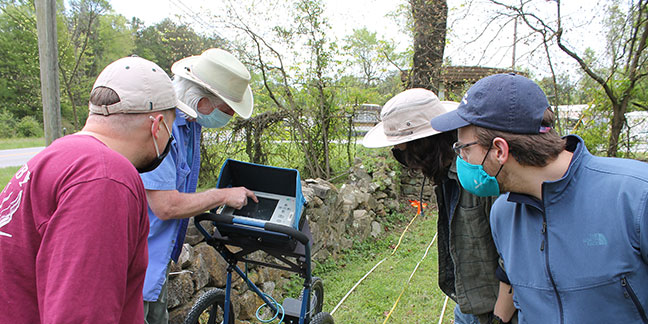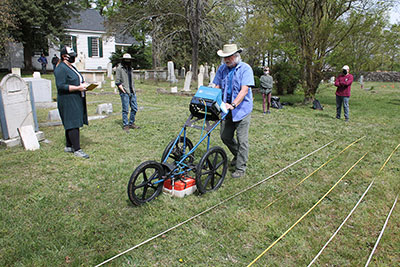 MOUNT HOLLY — Most everybody likes a good mystery and looking for an answer is part of the fun.
MOUNT HOLLY — Most everybody likes a good mystery and looking for an answer is part of the fun.
That’s what happened on April 16 and 17 at Old St Joseph Church in Mount Holly, when the case of a long-standing oral tradition concerning the possibility of unmarked graves being located in the cemetery was investigated by using high-tech ground penetrating radar (GPR).
The survey was conducted by UNC-Charlotte geology professor Dr. Andy Bobyarchick and a team of his applied geophysics students.
The survey project was a partnership between the Diocese of Charlotte and UNC-Charlotte, and part of the diocese’s ongoing work to preserve and restore the historic Old St. Joseph Church after completing a major renovation in 2018.
What prompted the investigation? Oral history stories of unmarked graves going back many years. Current St. Joseph’s caretaker Bill Bridgeman says his predecessor in that role, the late Carl Heil, often talked about the tales.
“He would get a tear in his eye whenever he spoke about it,” Bridgeman said.
Bryan Somerville is president of the Mecklenburg County Board of the Ancient Order of Hibernians. Somerville and his group take part in St. Patrick’s Day ceremonies held each year at the church, which was built by and for Irish immigrants in 1843.
“The oral histories are of unmarked burials possibly from the 1840s and 1850s,” Somerville said. “People knew if they put them inside the walls of a Catholic cemetery they would be on holy ground and protected.”
Old St. Joseph’s cemetery contains dozens of marked graves, which are already being cared for, but records are scant and it is presumed that other gravestones have been damaged or lost over time. The idea, from the diocese’s perspective, is that if the GPR survey finds additional unmarked graves in the surveyed area, the people buried there can be memorialized, cared for and respected.
 Somerville approached the diocese’s vicar general and chancellor, Monsignor Patrick Winslow, concerning the oral history stories and then he contacted UNC-Charlotte and Bobyarchick. Somerville was on site for the survey and eagerly watched the proceedings.
Somerville approached the diocese’s vicar general and chancellor, Monsignor Patrick Winslow, concerning the oral history stories and then he contacted UNC-Charlotte and Bobyarchick. Somerville was on site for the survey and eagerly watched the proceedings.
Legends and emotions aside, it was hard-fact science that Bobyarchick brought to the cemetery in the form of his GPR device. The machine sends out sound waves that are reflected back to a computer monitor. It also has a magnetometer that detects metal objects. Depending on the soil type and density, it can penetrate up to about 10 feet.
To start the survey, Bobyarchick and his students used long measuring tapes to lay out a grid on the ground. Then, the GPR machine was rolled along the rows in a slow and steady manner as the monitor revealed what lay beneath the surface.
“The radar sees everything in the subsurface that has an electrical contrast with the surrounding soil,” Bobyarchick said. “This includes rocks, roots, garbage, and many things of human origin like buried utilities (and sometimes graves).
“So, when we interpret the radar data, we speak in terms of anomalies. How strong is the reflected energy? How deep is the reflecting object? What is the shape of the reflecting object? If we are looking for unmarked graves, the radar will detect grave contents only if there is something to reflect the energy. In modern graves that include a metal casket and a vault, you usually see very strong reflections because of the metal in those objects. In older graves where the body might have been interred in a wooden coffin, the radar reflection will be much weaker to non-existent. Metal in the wooden coffin such as nails or handles might cause a reflection, and sometimes the grave shaft itself will show up as a lateral disturbance in the natural soil horizon.”
The survey action began on the morning of April l6 behind the church.
“We surveyed the section of ground along the back side of the church and before the rock wall,” Bobyarchick said. “This is the area that was our initial target and was thought on the basis of oral history to contain unmarked graves. As I looked at Cell A, as the area was called, I didn’t see any feature that I would call a grave. There are, however, several features that are of interest and yet to be determined.”
After surveying the rear area, the next day saw Bobyarchick and his team return to the church and lay out a grid in an open area in front of the cemetery and beside where marked graves are located. Several hours were spent skating the GPR device along the grass and peering intently at its monitor.
The students were excited to be taking part in an “in the field” expedition.
“Looking for possible graves gives us a deeper understanding of this area and its history,” said senior geology major Malori Harrington.
Harrington’s fellow student Summer Beamer was also thrilled about taking part in the survey. “It’s fascinating to think about the possibility of people being buried here that no one knew about.”
After the field work, Bobyarchick took the data back to his office for study, which will take some time to complete.
So what’s the bottom line regarding the legendary, unmarked grave mystery at Old St. Joseph Church?
“No, we have not solved the mystery for now,” Bobyarchick said. “GPR is really a first step in grave location, and for older burials it gets more and more difficult because the grave contents are not as reflective as modern caskets and vaults. For older burials you can get hints, but the proof is in the pudding, as we say.”
— Alan Hodge, Banner News. Reprinted with permission of the Banner News.


